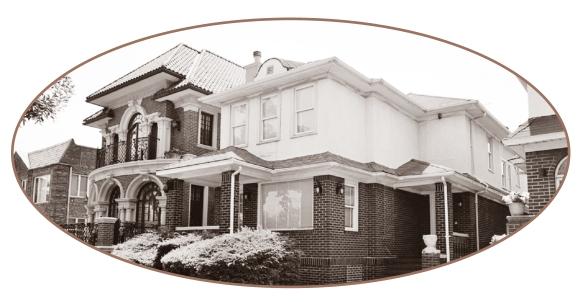中产,不只关乎收入
By Noah Smith

My late grandmother drilled1 into our heads that we were middle class. To her, this was a source of great pride; being middle class wasnt just better than being poor, it was also better than being rich. And she apparently wasnt alone. Surveys consistently find that most Americans consider themselves middle class. Although making more than $100,000 a year puts a household in the top 30 percent of the U.S. income distribution, a 2015 Pew survey found that most such people use some form of the label “middle class”to describe themselves.2
Some of this may be due to differences in local living costs—$100,000 is a great income in rural Kansas, but doesnt allow for much luxury in San Francisco. But some is probably due to the value Americans place on the idea of being middle class. Like my grandmother, they want to see themselves as being neither rich nor poor.
Where does this desire come from? For lower-income people, the desire to identify as middle class is clearly aspirational3. For higher earners, it may come from a sense of social humility; placing oneself above ones fellow citizens can appear unseemly and arrogant.4 But the desire to be seen as middle class isnt strictly personal. By wanting to identify as middle class, people like my grandmother are also expressing a desire to live in a middle-class society.
我國古语有云:不患寡而患不均。而在美国,即便资产足够雄厚,人们也更愿意把自己归为中产阶级。或许,人人都希望生活在一个相对平等的社会,而自己在其中的位置,最好也相对中立。那么,如何实现这一理想呢?
Theres plenty of evidence that visible signs of social inequality bother lots of people. For example, a recent paper by political scientists Melissa Sands and Daniel de Kadt found that when people in South Africa saw an expensive car, their willingness to raise taxes on the wealthy increased. Plenty of economics experiments in lab settings have found strong aversion5 to inequality.
Of course, there are many possible reasons for these effects. One is simply that poor people are envious or resentful of the rich. But this doesnt explain why many people seem to feel uncomfortable having more than others. In a common experiment called the dictator6 game, involving the division of a pot of money, subjects who have the power to keep all the money for themselves tend to give some of it away. And when the so-called dictator has the power to divide money up among others, he or she tends to prefer an equitable distribution.
Furthermore, surveys regularly find that Americans underestimate the amount of inequality in their midst7—although this could be due to simple ignorance, or an illusion created by neighborhoods where most people have similar incomes. But it also probably reflects wishful thinking. The idea of an unequal society probably offends many people, even those on top of the hierarchy8.
Understanding exactly how and why inequality bothers people is the key to creating a happier society. Traditional remedies include redistribution of income and wealth through taxation, as well as so-called predistribution—reshaping the economic system to produce more equal market outcomes—through unions and other pro-worker institutions.9
Although compressing the distribution might be good, there may be additional approaches that foster a broader middle-class sensibility.10 Reducing actual inequality is good, but reducing visible status differences along a few important dimensions may also be helpful.

For example, theres public space. In a society where beaches are private, communities are gated and open space is fenced off, people without access to the land are constantly reminded of their subordinate position in society.11 But public parks, beaches, roads and other common areas create a feeling of inclusiveness and equality. These are spaces where the wealthy mingle with those of lesser means12 on a plane of rough equality—he may have a more expensive beach umbrella, but on a public beach a rich person is just another human being sharing the same sand and water as everyone else. Public transportation is similar—when the wealthy ride the same local trains as common laborers, it creates a space where visible status differences are reduced.
Housing can also help reduce perceptions of glaring disparity.13 When wealthy people live in mansions and poor people in shacks14, it provides a constant reminder of inequality. But building public housing or subsidized rental units in dense cities allows low-income people to have dwellings that, while not the same as multimilliondollar condominiums, are not wildly different either.15 The suburbs, whose sprawl is often bad for the environment but provides many lower-income people with the opportunity to own a free-standing home,16 can also provide a form of equality—especially if the government assists people of modest means to own their own homes.
A third example is public education. Integration17 of school districts puts kids from wealthier backgrounds in the same classes and the same social settings as kids of lower socioeconomic18 status. They eat at the same tables, do the same homework and (mostly) join the same clubs.
In addition to compressing the income and wealth distributions, therefore, society can foster a middle-class esprit by providing public goods and services—spaces and institutions that reduce or eliminate invidious status differences.19 This is a way to justify peoples perceptions of being middle class, and cement20 the idea that we live in a middle-class society. Its a way to encourage people to connect with their common humanity, and with the broader communities of their cities and their nations. Ultimately, that connection and feeling of commonality21 might really be what defines the middle class.
1. drill sth. into sb./sb.s head:
(通过练习)反复灌输。
2. 2015年皮尤研究中心的调查显示,有些家庭尽管年收入超过10万美元,在美国属于前30%的水平,但依然愿意用“中产阶级”一类的标签来形容自己。Pew: 皮尤研究中心,美国的一家独立民调机构和智库机构。
3. aspirational: 有志向的,渴望获得更大成功的。
4. humility: 谦恭,谦逊;unseemly: 不恰当的,不得体的;arrogant: 傲慢的,自大的。
5. aversion: 厌恶,反感。
6. dictator: 独裁者。游戏中受试者可以随意分配财富,故称之为独裁者。
7. in their midst: 在他们当中。
8. hierarchy: 等级制度。
9. 传统的补救方法是通过税收对收入和财富进行再分配,或者通过工会和其他有利于工人的组织,重新规划经济体制,使市场结果更为公平,也即所谓的“预分配”。remedy:补救方法。
10. compress: 压缩;foster: 促进,培养。
11. 如果有一个社会,沙滩是私人的,小区设了门禁,很多露天场所都被围了起来,那么,那些进不去的人就总会觉得自己的社会地位低人一等。subordinate:下级的,处于次要地位的。
12. means: [复数] 金钱,财富。
13. glaring:(负面事物)显眼的,易见的;disparity: 不平等,差异。
14. shack: 简陋小屋,棚屋。
15. 如果在人口稠密的城市建造公房或廉租房,使低收入群体也住有所居,虽然比不上造价高昂的公寓楼,但差别也不至于太大。subsidize: 给……津贴;condominium: 公寓大楼。
16. sprawl:(建筑群或市镇的)无计划发展;free-standing: 独立的。
17. integration: 融合,整合。
18. socioeconomic: 社会经济的。
19. esprit: 精神;invidious: 招致不满的,激起怨恨的。
20. cement: 加强,巩固。
21. commonality: 共同特性,共性。
阅读感评
∷秋叶 评
马克思、恩格斯在《共产党宣言》(1848)中将当时的欧洲社会划分为两大阶级:资产阶级与无产阶级。他们认为前者掌握生产资料并获得大部分劳动成果,而后者一无所有,仅靠出卖劳动力来赚取报酬以维持基本的生活。因此,两个阶级属于剥削与被剥削、压迫与被压迫的关系,其矛盾对立无法调和,阶级斗争贯穿资本主义社会的始终。到了大约一个半世纪后的今天,时代特征与社会面貌已发生了巨大的變化,《共产党宣言》里关于阶级或阶层的分析与判断未必符合当前的实际情况,但有些东西恐怕基本上是不会变化的,或者说属于人类社会的常态,如贫富的分化、阶级(阶层)的分野以及由此产生的对立情绪与社会问题等。那么,在这讲求平等和谐的社会里,如何才能淡化这些不良因素的存在感呢?在这个世界上几乎被一致认可的办法就是最大限度地扩大中产阶级,哪怕是种“中产心态”也好!
中产阶级是个相当宽泛的概念,几乎涵盖了所有靠自己的劳动(包括脑力与体力)所得,能满足至少是基本的物质与精神生活需求的社会人群。美国学者保罗·富塞尔(Paul Fussell)在其分析美国社会阶层的论著《格调:社会等级与生活品味》(Class: A Guide Through the American Status System, 1983)里,将整个美国社会粗分为三大阶层,即Top(上层)、Center(中层)与Bottom(底层),然后又将每个阶层细分为若干层级,其中Center从高到低依次分为Middle(中产)、High Proletarian(工人阶级高层)、Mid-Proletarian(工人阶级中层)与Low
Proletarian(工人阶级低层)四类。
原文标题的“Being Middle Class Isnt Just a Matter of Income”(成为中产阶级并不仅仅靠收入多寡)并未对Middle Class进行较为明确的经济定义与社会定位,而是强调该阶层的价值观和心态对于社会公平与幸福感所发挥的强大作用。原文认为,厕身中产阶层不仅有幸脱离了贫困,还要好过富裕阶层,原因是人们自知生活水平超越他人会觉不妥并显得傲慢,只有“天下为公、人人平等”才能心安理得。因此,人们一门心思要生活在中产社会之中。显然,这种认识与我们平常对于人类总是力图“往上爬”(climb the social ladder)并设法“与众不同”(make a difference)的本性的印象颇为相左,带有比较浓烈的理想化倾向。上文提到的富塞尔就认为,中产阶级总是急于同低于它的阶层拉开距离,并千方百计地强调其往上爬的诉求,于是他们在外表装束、语言使用等外在形式上,都要显得与众不同并且自命不凡。在这位美国作者看来,中产阶级处于白领的底层,数量最多,但他们总是试图让他人误认为自己属于中上层阶级(Upper Middle Class,是Top一层的最低层),摆出自己的“好品味”。原因很简单,中上层阶级是他们的梦想阶层,虽然这个阶层的人士照样得工作,但他们却是“金领”,或者“白领”中的佼佼者。
其实,原文的主旨并非在谈论所谓的中产阶级,而是在为社会的稳定与和谐支招儿。在作者看来,中产阶级的价值观最有益于一个稳定、和谐、幸福社会的创建,因此中产阶级应成为整个社会的标杆,即便是对于那些在硬指标上“尚未达标”的阶层,社会上也得营造出一种让他们感觉“靠近中产”的软环境,最大限度地扩大公共资源,让人们共享共有,以营造一种包容与平等的氛围。诚然,等级之间的差异是客观存在的,任何时代、任何社会都无法改变。其外在上的显著表现无非是住宅、娱乐场所、交通工具、教育机构以及外表装扮等等。然而,如果我们尽量淡化上述的等级指标(indicator of class),就可以在很大程度上消解因不良攀比(invidious comparison)而导致的不同阶层的“羡慕嫉妒恨”,从而超越阶层鸿沟。

